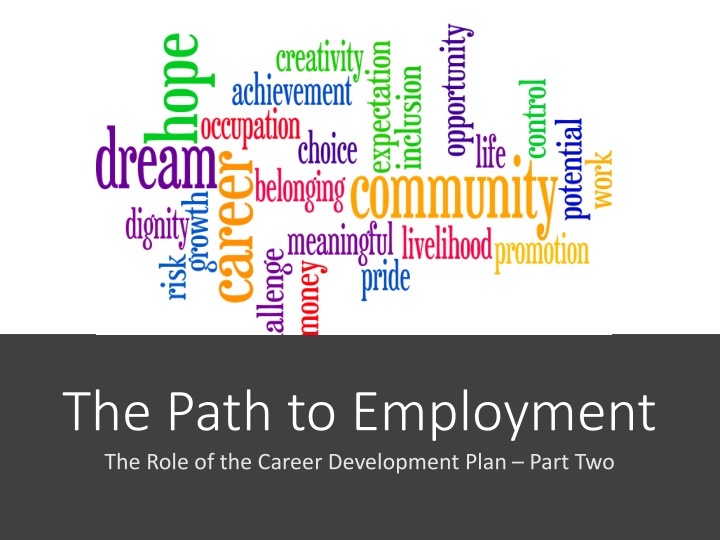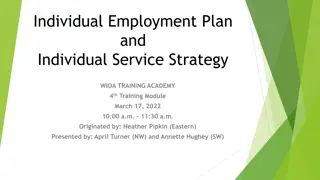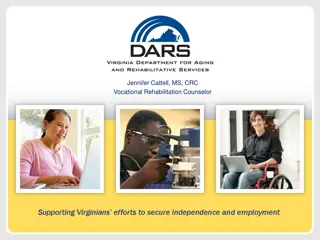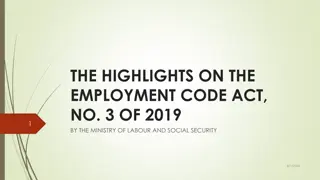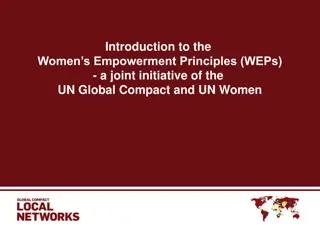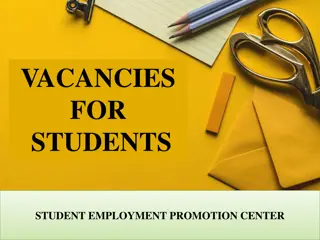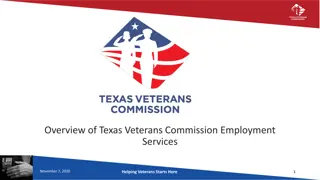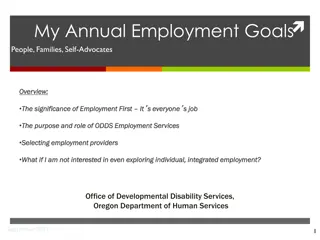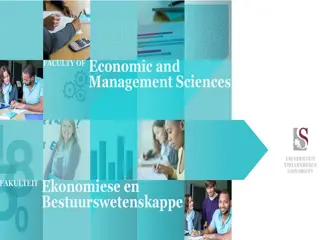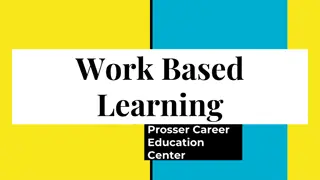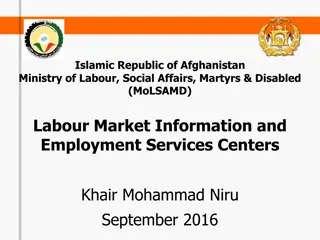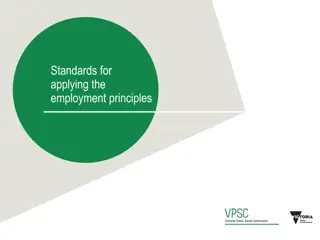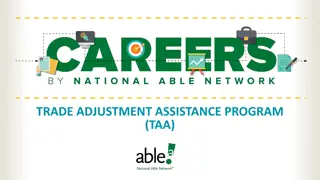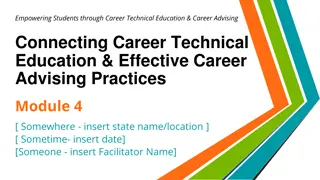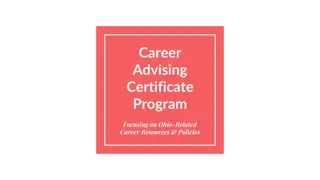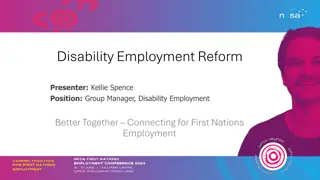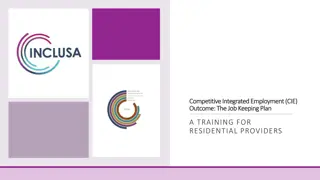Empowerment through Career Development for Employment Success
Empower individuals by clearly communicating career aspirations, emphasizing the importance of competitive integrated employment, and promoting self-esteem and adaptability in the workplace. Explore resources and tools to aid decision-making towards fulfilling employment outcomes.
Download Presentation

Please find below an Image/Link to download the presentation.
The content on the website is provided AS IS for your information and personal use only. It may not be sold, licensed, or shared on other websites without obtaining consent from the author.If you encounter any issues during the download, it is possible that the publisher has removed the file from their server.
You are allowed to download the files provided on this website for personal or commercial use, subject to the condition that they are used lawfully. All files are the property of their respective owners.
The content on the website is provided AS IS for your information and personal use only. It may not be sold, licensed, or shared on other websites without obtaining consent from the author.
E N D
Presentation Transcript
The Path to Employment The Role of the Career Development Plan Part Two
Clearly communicate what someone wants to happen in regard to employment for their ISP year. The Role of the Career Development Plan (CDP) is to: It is critical that the person understands that what they select will be the basis for their employment - related supports for the upcoming ISP year. A person may change their mind and their CDP at any time. 2
Competitive, integrated employment is the goal of all ODDS employment services. There are no tests to pass or services a person must have before exploring, pursuing and/or obtaining individual, integrated employment. Use resources to make decisions about selecting employment providers such as the data at: https://spdweb.hr.state.or.us/EOS/Data https://spdweb.hr.state.or.us/EOS/Data Key Points If someone does not want to explore integrated employment, efforts should be made to understand why and how people of working age arrive at the decision not to explore, pursue, obtain, maintain or advance in individual, integrated employment. The Employment Discussion Guide is one tool that may play a instrumental role in gaining such insight. 3
Griffin et al. (1996) found higher levels of self esteem as well as job satisfaction for those in supported employment than for those in sheltered employment. Why Employment is Important ~ Akkerman, September 2016 4
. . . Having career adaptability, or considering oneself able to construct own future career intentions and to cope with career transitions and difficult work situations, may also favor. . . positive feelings to face difficulties and to succeed in what is important for [a person with an intellectual disability] (Scioli et al., 2011), thus stimulating even greater feelings of life satisfaction. Why Employment is Important ~ Santilli, 2014 5
Physical/ Occupational Therapy Everything Supports Employment My Job Residential Supports Communication Supports Behavior Supports 6
A statement that reflects how things will be. Verbs are important . . . - Gary shall What is an Employment Outcome? - Bridget will know how to - Corey is able to ODDS employment services are resources people can use to reach their employment outcomes 7
Action Plans Desired Outcome: How often or date due Where will it happen Who is responsible Where to record Measurable steps that will be taken to reach the desired outcome Notes A: D: 9
Desired Employment Outcomes Not an Employment Outcome An Employment Outcome Amanda will participate in Employment Path Community. Amanda will be knowledgeable about in-demand occupations in her community by meeting with the local American Job Center staff. John will participate in Small Group Employment. John will be skilled at using the riding lawn mower. Kayla likes to work around people. Kayla has a job where she interacts with people. Stan will continue to work in the sheltered workshop. Stan understands that he has a wide variety of employment options because he has toured businesses that match his interests and skills. Giselle will work with her job coach. Giselle knows and understands her job duties and uses natural supports when she needs assistance. 10
Who is Responsible: By being as specific as possible, you will increase the person s chances for success. At the minimum, list the name of the provider when waiver - funded employment supports are used. Getting & Staying on Track Timelines or Frequency: Specify how often this needs to be done and/or a date by which it will be accomplished. Record Progress: Providers must record progress and must ensure that the case manager has the current implementation strategies which may include action plans. Monitor: While this information may be in another document, it needs to be available so the case manager can monitor it. * Provider refers to organizations that deliver employment services. It also extends to PSWs who provide employment services 1
Focus on investing the persons time to realize their desired outcomes Where steps occur Who is responsible How often or due date Where to record Notes Action Plans 12
Transitioning out of high school in June Her dream is to work in an office. She uses Facebook and Instagram to communicate with her friends. Susan Graham She takes a zumba class at the YWCA twice a week. She and her parents worry that she ll be bored once she is out of school. 13
Has worked at Acme Hardware for ten months Works between 10-12 hours a week. Would like to work 25 hours a week. Would like to pitch in more by learning how to: make keys; refill propane tanks and use the new inventory system. Glen Hansen He is highly respected by his co-workers and his boss. His co-workers, Mitch and Jake, taught him the current inventory system. Has come to work in a dirty uniform sometimes. Lives with three roommates and has residential supports. 14
Has worked in the workshop for 15 years He thinks he might want to work in the community but he is not sure. Jack and his family are worried that he ll lose touch with his friends if he leaves the workshop. Jack Hudson He enjoys fishing in the local lake. He really likes deep sea fishing when he can get to the ocean. He likes building things, especially with wood. He depends on his provider for transportation. 15
The Power of Work 16
Akkerman, A., Janssen, C. G., Kef, S., & Meininger, H. P. (2016). Job satisfaction of people with intellectual disabilities in integrated and sheltered employment: an exploration of the literature. Journal of Policy and Practice in Intellectual Disabilities,13(3), 205-216. Ellenkamp, J.J.H., Brouwers, E.P.M., Embregts, P.J.C.M. et al. Journal of Occupational Rehabilitation (2016) 26: 56. Work environment-related factors in obtaining and maintaining work in a competitive employment setting for employees with intellectual disabilities: a systematic review https://doi.org/10.1007/s10926-015-9586-1 References https://doi.org/10.1007/s10926-015-9586-1 Santilli, Sara & Rochat, Sh kina & Marcionetti, Jenny & Rossier, J r me. (2016). Career adaptability, hope, optimism, and life satisfaction in Italian and Swiss adolescents. Journal of Career Development. 44. 10.1177/0894845316633793. 17
Julie Huber Office of Developmental Disability Services Contact Information Oregon Department of Human Services julie.l.huber@state.or.us julie.l.huber@state.or.us 18
